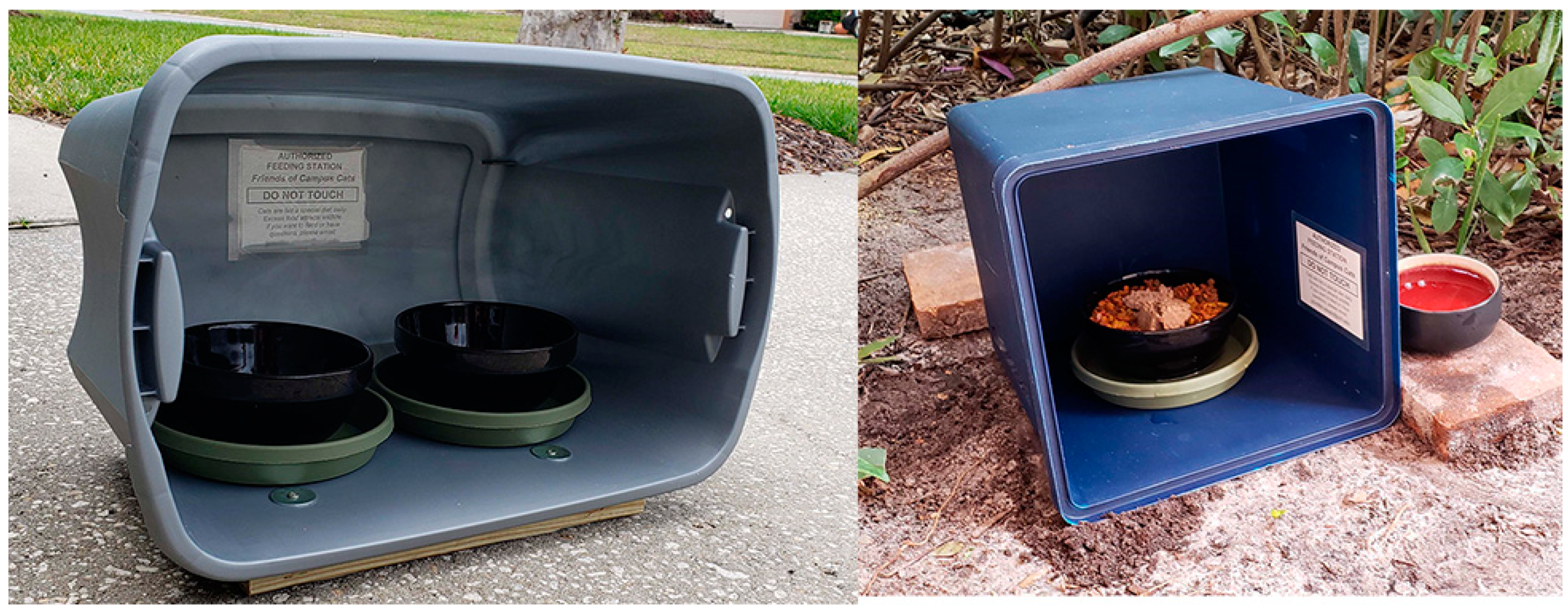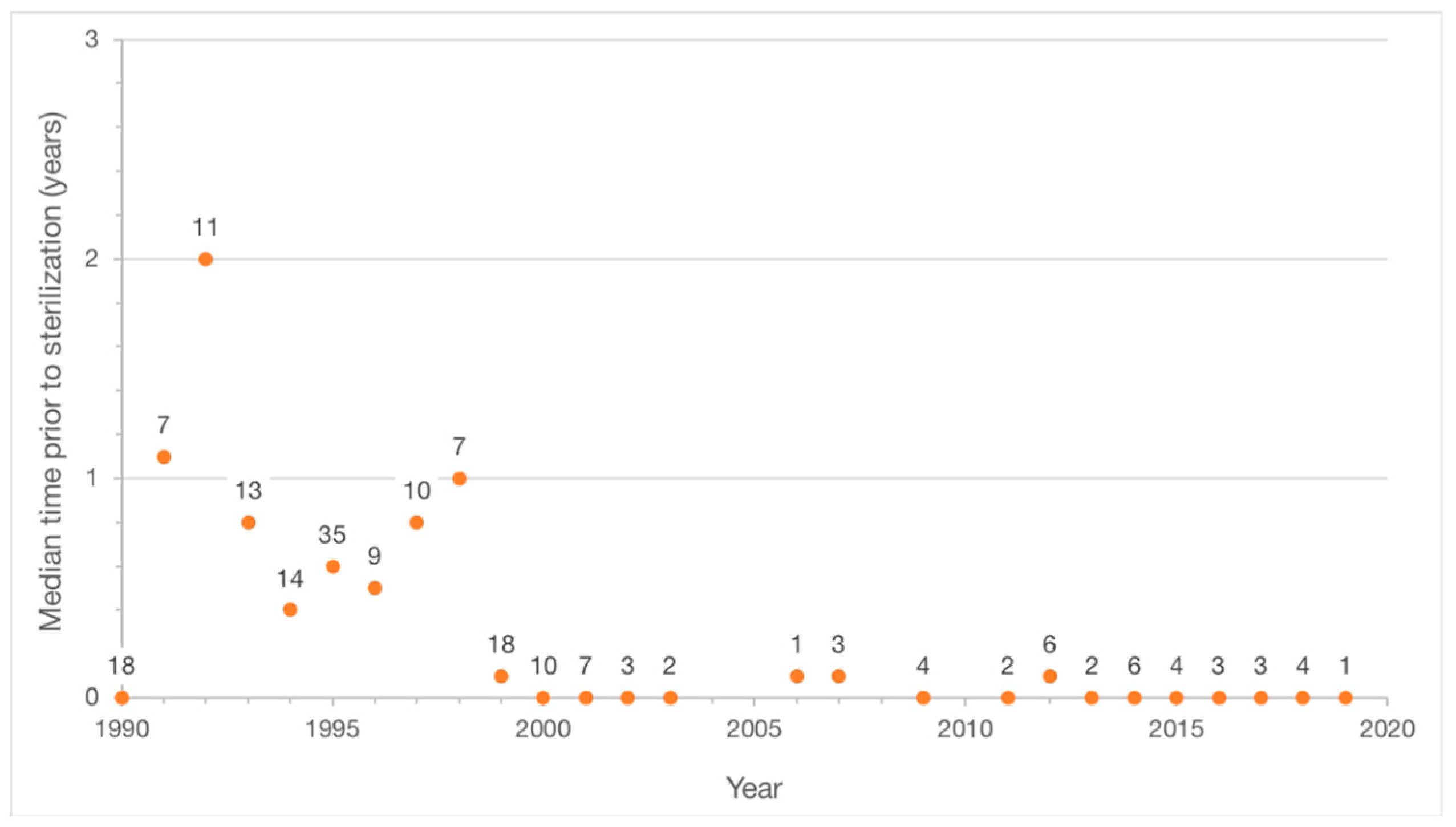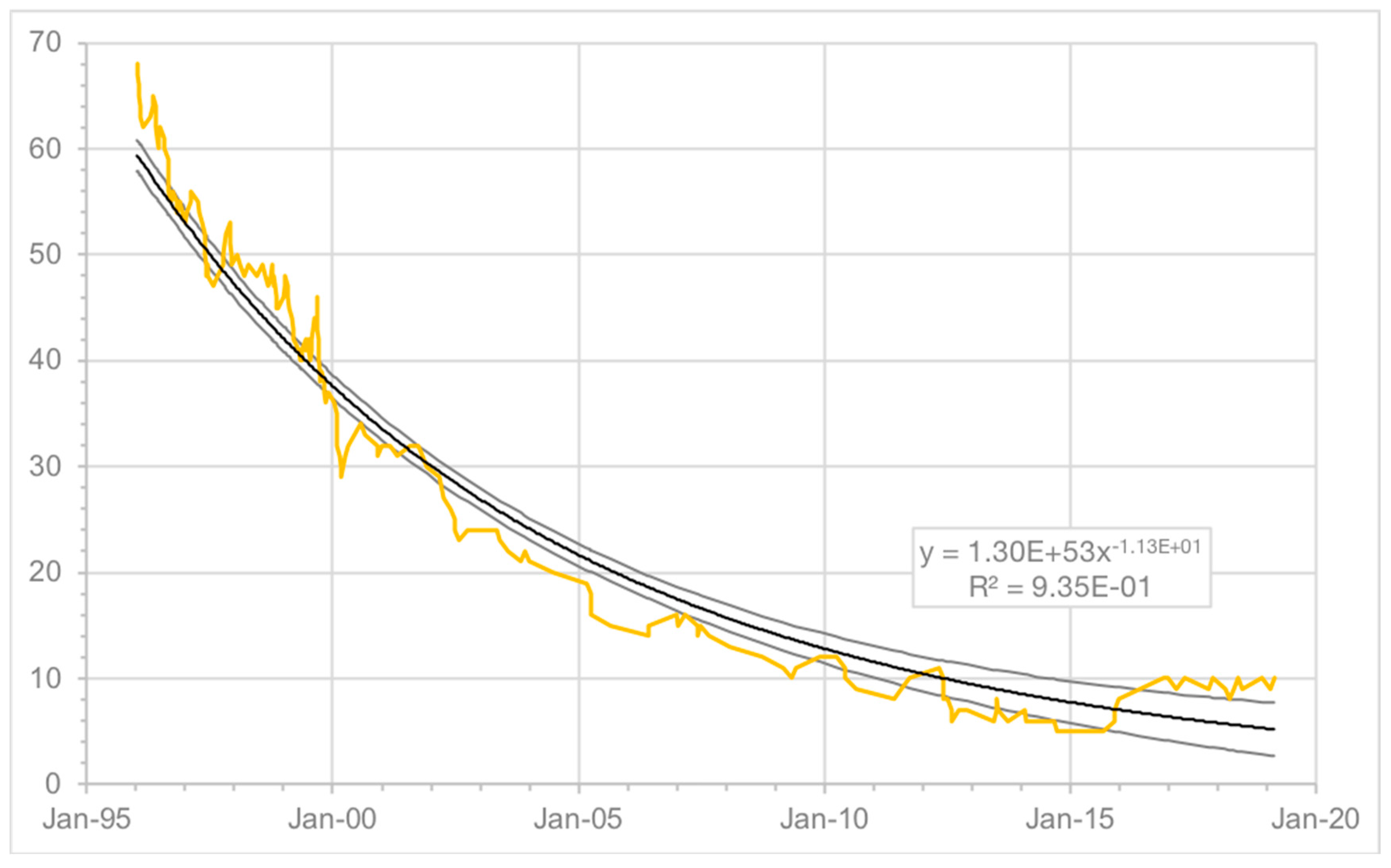Back to School: An Updated Evaluation of the Effectiveness of a Long-Term Trap-Neuter-Return Program on a University’s Free-Roaming Cat Population
Simple Summary
Abstract
1. Introduction
2. Materials and Methods
2.1. Location
2.2. Background
2.3. Data Collection
2.4. Data Analysis
3. Results
4. Discussion
4.1. Population Size
4.2. Disposition
4.3. Population Dynamics
4.4. Colony Changes
5. Study Limitations
6. Conclusions
Author Contributions
Funding
Acknowledgments
Conflicts of Interest
References
- Longcore, T.; Rich, C.; Sullivan, L.M. Critical Assessment of Claims Regarding Management of Feral Cats by Trap-Neuter-Return. Conserv. Biol. 2009, 23, 887–894. [Google Scholar] [CrossRef] [PubMed]
- Gerhold, R.W.; Jessup, D.A. Zoonotic Diseases Associated with Free-Roaming Cats. Zoonoses Public Health 2012, 60, 189–195. [Google Scholar] [CrossRef] [PubMed]
- Marra, P.P.; Santella, C. Cat Wars: The Devastating Consequences of a Cuddly Killer; Princeton University Press: Princeton, NJ, USA, 2016; ISBN 9781400882878. [Google Scholar]
- Winograd, N.J. Redemption: The Myth of Pet Overpopulation and the no Kill Revolution in AMERICA; Almaden Books: Cambridge, MA, USA, 2007; ISBN 9780979074318. [Google Scholar]
- Grimm, D. Citizen Canine: Our Evolving Relationship with Cats and Dogs; PublicAffairs: New York, NY, USA, 2014; ISBN 9781593786441. [Google Scholar]
- Berkeley, E.P. TNR Past Present and Future: A History of the Trap-Neuter-Return Movement; Alley Cat Allies: Bethesda, MD, USA, 2004; ISBN 9780970519429. [Google Scholar]
- Wolf, P.J.; Schaffner, J.E. The Road to TNR: Examining Trap-Neuter-Return Through the Lens of Our Evolving Ethics. Front. Vet. Sci. 2019, 5, 341. [Google Scholar] [CrossRef] [PubMed]
- Boone, J.D.; Miller, P.S.; Briggs, J.R.; Benka, V.A.; Lawler, D.F.; Slater, M.; Levy, J.K.; Zawistowkski, S. A Long-Term Lens: Cumulative Impacts of Free-Roaming Cat Management Strategy and Intensity on Preventable Cat Mortalities. Front. Vet. Sci. 2019, 6, 238. [Google Scholar] [CrossRef] [PubMed]
- Neville, P.F.; Remfry, J. Effect of neutering on two groups of feral cats. Vet. Rec. J. Br. Vet. Assoc. 1984, 114, 447–450. [Google Scholar] [CrossRef] [PubMed]
- Centonze, L.A.; Levy, J.K. Characteristics of free-roaming cats and their caretakers. J. Am. Vet. Med. Assoc. 2002, 220, 1627–1633. [Google Scholar] [CrossRef]
- Levy, J.K.; Gale, D.W.; Gale, L.A. Evaluation of the effect of a long-term trap-neuter-return and adoption program on a free-roaming cat population. J. Am. Vet. Med. Assoc. 2003, 222, 42–46. [Google Scholar] [CrossRef] [PubMed]
- Stoskopf, M.K.; Nutter, F.B. Analyzing approaches to feral cat management—One size does not fit all. J. Am. Vet. Med. Assoc. 2004, 225, 1361–1364. [Google Scholar] [CrossRef]
- Nutter, F.B. Evaluation of a Trap-Neuter-Return Management Program for Feral Cat Colonies: Population Dynamics, Home Ranges, and Potentially Zoonotic Diseases; North Carolina State University: Raleigh, NC, USA, 2005. [Google Scholar]
- Natoli, E.; Maragliano, L.; Cariola, G.; Faini, A.; Bonanni, R.; Cafazzo, S.; Fantini, C. Management of feral domestic cats in the urban environment of Rome (Italy). Prev. Vet. Med. 2006, 77, 180–185. [Google Scholar] [CrossRef]
- Hughes, K.L.; Slater, M.R. Implementation of a Feral Cat Management Program on a University Campus. J. Appl. Anim. Welf. Sci. 2002, 5, 15–28. [Google Scholar] [CrossRef]
- Zaunbrecher, K.I.; Smith, R.E. Neutering of feral cats as an alternative to eradication programs. J. Am. Vet. Med. Assoc. 1993, 203, 449–452. [Google Scholar] [PubMed]
- Bissonnette, V.; Lussier, B.; Doize, B.; Arsenault, J. Impact of a trap-neuter-return event on the size of free-roaming cat colonies around barns and stables in Quebec: A randomized controlled trial. Can. J. Vet. Res. 2018, 82, 192–197. [Google Scholar] [PubMed]
- Castillo, D.; Clarke, A.L. Trap/Neuter/Release Methods Ineffective in Controlling Domestic Cat “Colonies” on Public Lands. Nat. Areas J. 2003, 23, 247–253. [Google Scholar]
- Swarbrick, H.; Rand, J.; Swarbrick, H.; Rand, J. Application of a Protocol Based on Trap-Neuter-Return (TNR) to Manage Unowned Urban Cats on an Australian University Campus. Animals 2018, 8, 77. [Google Scholar] [CrossRef]
- Spehar, D.D.; Wolf, P.J. A Case Study in Citizen Science: The Effectiveness of a Trap-Neuter-Return Program in a Chicago Neighborhood. Animals 2018, 8, 14. [Google Scholar] [CrossRef] [PubMed]
- Kreisler, R.E.; Cornell, H.N.; Levy, J.K. Decrease in Population and Increase in Welfare of Community Cats in a Twenty-Three Year Trap-Neuter-Return Program in Key Largo, FL: The ORCAT Program. Front. Vet. Sci. 2019, 6, 7. [Google Scholar] [CrossRef] [PubMed]
- Spehar, D.D.; Wolf, P.J. An Examination of an Iconic Trap-Neuter-Return Program: The Newburyport, Massachusetts Case Study. Animals 2017, 7, 81. [Google Scholar] [CrossRef]
- UCF Facts 2018–19|University of Central Florida—Orlando, FL. Available online: https://www.ucf.edu/about-ucf/facts/ (accessed on 7 June 2019).
- UCF Arboretum. Available online: https://arboretum.ucf.edu/ (accessed on 10 June 2019).
- Natoli, E.; Malandrucco, L.; Minati, L.; Verzichi, S.; Perino, R.; Longo, L.; Pontecorvo, F.; Faini, A. Evaluation of Unowned Domestic Cat Management in the Urban Environment of Rome After 30 Years of Implementation of the No-Kill Policy (National and Regional Laws). Front. Vet. Sci. 2019, 6, 31. [Google Scholar] [CrossRef]
- Gale, D.W.; Gale, L.A. Friends of Campus Cats, Orlando, FL, USA. Personal communication, 2019. [Google Scholar]
- APPA. 2017–2018 APPA National Pet Owners Survey; American Pet Products Association: Stamford, CT, USA, 2019. [Google Scholar]
- Nutter, F.B.; Levine, J.F.; Stoskopf, M.K. Reproductive capacity of free-roaming domestic cats and kitten survival rate. J. Am. Vet. Med. Assoc. 2004, 225, 1399–1402. [Google Scholar] [CrossRef]
- Gunther, I.; Finkler, H.; Terkel, J. Demographic differences between urban feeding groups of neutered and sexually intact free-roaming cats following a trap-neuter-return procedure. J. Am. Vet. Med. Assoc. 2011, 238, 1134–1140. [Google Scholar] [CrossRef]
- Lindsay, S. The 37 Biggest Colleges in the United States. Available online: https://blog.prepscholar.com/the-biggest-colleges-in-the-united-states (accessed on 17 June 2019).
- Kortis, B.; Richmond, S.; Weiss, M.; Frazier, A.; Needham, J.; McClurg, L.; Senk, L.G. Neighborhood Cats TNR Handbook, 2nd ed.; Neighborhood Cats, Inc.: New York, NY, USA, 2013. [Google Scholar]
- Tan, K.; Rand, J.; Morton, J. Trap-Neuter-Return Activities in Urban Stray Cat Colonies in Australia. Animals 2017, 7, 46. [Google Scholar] [CrossRef] [PubMed]
- Levy, J.K.; Isaza, N.M.; Scott, K.C. Effect of high-impact targeted trap-neuter-return and adoption of community cats on cat intake to a shelter. Vet. J. 2014, 201, 269–274. [Google Scholar] [CrossRef] [PubMed]





| Variable | Feral | Socialized | Total |
|---|---|---|---|
| Population | 161 | 43 | 204 |
| Age | |||
| Kittens | 81 | 12 | 93 |
| Adults | 80 | 31 | 111 |
| Sex | |||
| Male | 92 | 22 | 114 |
| Female | 69 | 21 | 90 |
| Disposition | No. of Cats (%) | Sex | Socialization | Age | Time on Campus (Years) | |||||
|---|---|---|---|---|---|---|---|---|---|---|
| M | F | Feral | Sociable | Kitten | Adult | Mean ± SD | Median | Range | ||
| Remaining | 10 (5%) | 3 | 7 | 10 | 0 | 0 | 10 | 3.5 ± 3.1 | 3.0 | 0.3–10.0 |
| Adopted | 92 (45%) | 45 | 47 | 57 | 35 | 28 | 64 | 2.1 ± 3.4 | 0.3 | 0–16.3 |
| To woods | 10 (5%) | 7 | 3 | 10 | 0 | 0 | 10 | 1.5 ± 2.6 | 0.3 | 0–9.0 |
| Out of area | 3 (1%) | 2 | 1 | 3 | 0 | 0 | 3 | 0 | - | - |
| Disappeared | 49 (24%) | 29 | 20 | 48 | 1 | 0 | 49 | 4.4 ± 4.2 | 3.1 | 0–15.2 |
| Died | 17 (8%) | 11 | 6 | 16 | 1 | 0 | 17 | 3.8 ± 2.6 | 3.9 | 0.3–8.3 |
| Euthanized | 23 (11%) | 17 | 6 | 17 | 6 | 0 | 23 | 4.6 ± 4.4 | 4.3 | 0–13.6 |
| Total | 204 | 114 | 90 | 161 | 43 | 28 | 176 | 3.1 ± 3.8 | 1.6 | 0–16.3 |
| Adoptions; Age and Level of Socialization | 2002 | 2019 | ||
|---|---|---|---|---|
| Total on Campus | No. Adopted (%) | Total on Campus | No. Adopted (%) | |
| Socialized | ||||
| Adults | 27 | 19 (70) | 31 | 23 (74) |
| Kittens | 12 | 12 (100) | 12 | 12 (100) |
| Feral | ||||
| Adults | 41 | 9 (22) | 80 | 20 (25) |
| Kittens | 75 | 33 (44) | 81 | 37 (46) |
| Total | 155 | 73 (47) | 204 | 92 (45) |
| Program Location (Source) | University of Central Florida | Newburyport, Massachusetts (22) | Key Largo, Florida (21) | Chicago, Illinois (20) | Sydney, Australia (19) |
|---|---|---|---|---|---|
| Duration (years) | 28 | 17 | 14 | 4–10 | 9 |
| Cat population | |||||
| Total managed | 204 | ~340 | 2529 | 195 | 122 |
| Initial census | 68 | ~300 | 455 | 75† | 69 |
| Remaining cats | 10 | 0 | 206 | 44 | 15 |
| (%) | 5 | 0 | 8 | 23 | 12 |
| Population reduction (%) | 85 | 100 | 55 | 41 | 78 |
| Colonies eliminated vs. total | 11/16 | 13/14‡ | 41/85‡ | 8/20 | NR |
| Disposition: | |||||
| Adoption (%) | 45 | ~33 | 28 ^ | 30 | 27 |
| Disappeared (%) | 24 | NR | NR | 34 | 29 |
| Euthanized (%) | 11 | ~5–10 | 17 ^ | 3 | 17 |
| Died (%) | 8 | NR | 11 ^ | 7 | 12 |
© 2019 by the authors. Licensee MDPI, Basel, Switzerland. This article is an open access article distributed under the terms and conditions of the Creative Commons Attribution (CC BY) license (http://creativecommons.org/licenses/by/4.0/).
Share and Cite
Spehar, D.D.; Wolf, P.J. Back to School: An Updated Evaluation of the Effectiveness of a Long-Term Trap-Neuter-Return Program on a University’s Free-Roaming Cat Population. Animals 2019, 9, 768. https://doi.org/10.3390/ani9100768
Spehar DD, Wolf PJ. Back to School: An Updated Evaluation of the Effectiveness of a Long-Term Trap-Neuter-Return Program on a University’s Free-Roaming Cat Population. Animals. 2019; 9(10):768. https://doi.org/10.3390/ani9100768
Chicago/Turabian StyleSpehar, Daniel D., and Peter J. Wolf. 2019. "Back to School: An Updated Evaluation of the Effectiveness of a Long-Term Trap-Neuter-Return Program on a University’s Free-Roaming Cat Population" Animals 9, no. 10: 768. https://doi.org/10.3390/ani9100768
APA StyleSpehar, D. D., & Wolf, P. J. (2019). Back to School: An Updated Evaluation of the Effectiveness of a Long-Term Trap-Neuter-Return Program on a University’s Free-Roaming Cat Population. Animals, 9(10), 768. https://doi.org/10.3390/ani9100768





